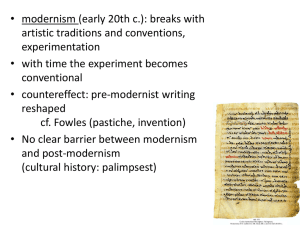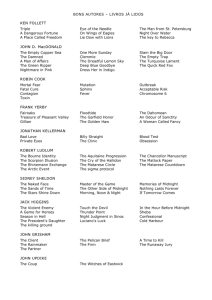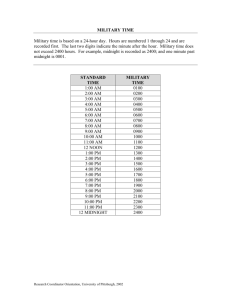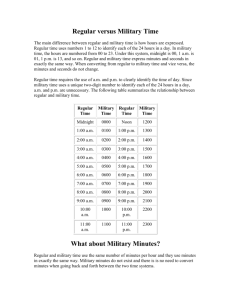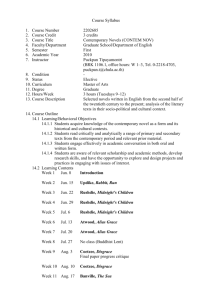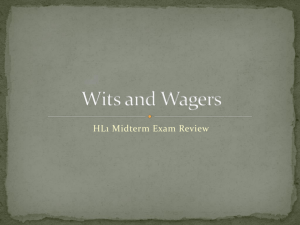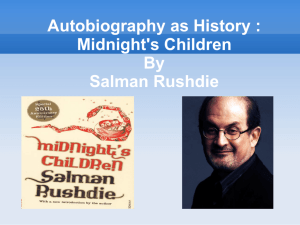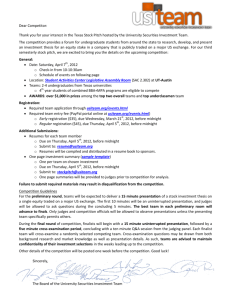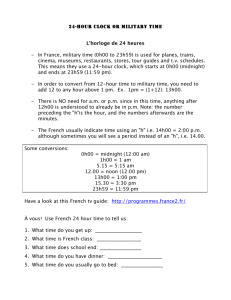Salman Rushdie: General Introduction
advertisement
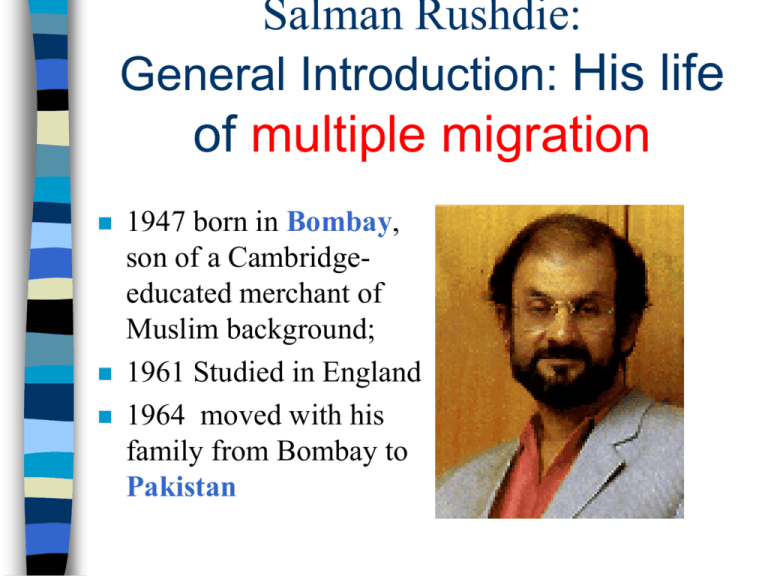
Salman Rushdie: General Introduction: His life of multiple migration 1947 born in Bombay, son of a Cambridgeeducated merchant of Muslim background; 1961 Studied in England 1964 moved with his family from Bombay to Pakistan Salman Rushdie: General Introduction (2) 1975: Grimus; 1987: The Jaguar Smile: A Nicaraguan Journey; 1990: Haroun and the Sea of Stories 1980: Midnight's Children 1983: Shame 1989: The Satanic Verses 1989, Feb. "fatwa" 1991: Imaginary Homelands 1994: East, West 1995: The Moor's Last Sigh 1999: The Ground Beneath her Feet Questions: Definitions and Implications: immigrant, emigrant, expatriates, exile, contract laborers. What are special about immigrant literature and writers? Rushdie’s position as an immigrant writer Third-World Cosmopolitans like Derek Walcott, Gabriel Garcia Marques and Bharati Mukherjee, V. S. Naipaul and Michael Ondaatje, and 北島. They live in or write to a metropolitan center, carrying with them a “third-world,” or multicultural, background. The complexity of their positions: 1. Enabling, “The Empire Writes Back.” 2. Awkward. Is Rushdie a "'British-resident IndoPakistani writer'? Who do they write to? What do they write about? Rushdie: migrant identity What is the best thing about migrant peoples and seceded nations? I think it is their hopefulness... And what is the worst thing? It is the emptiness of one's luggage....We have floated upwards from history, from memory, from Time. (Shame 70-71) “[Pakistan] is a part of the world to which, whether I like it or not, I am still joined, if only by elastic bands.” (Shame 23) “It maybe be argued that the past is a country from which we have all migrated, that its loss is part of our common humanity. . . .” (“Imaginary Homelands”) Rushdie: Pakistan & migrant writer Although I have known Pakistan for a long time, I have never lived there for longer than six months at a stretch...I have learned Pakistan by slices...however I choose to write about over-there, I am forced to reflect that in fragments of broken mirrors...I must reconcile myself to the inevitability of the missing bits. ... (Shame 70) Immigrant writer: "the ability to see at once from inside and out is a great thing, a piece of good fortune which the indigenous writer cannot enjoy." (IH 4) The only people who see the whole picuture. . . Are the ones who step out of the frame.” (The Ground 43) “ Other metaphors or descriptions of immigrant writers 鷺 鷥 在 水 上 書 寫 無 人 失 敗 的 黃 昏 一 隻 孤 狼 走 進 踏 著 那 節 奏 搥 打 著 夢 中 之 鐵 關 鍵 詞 , 我 的 影 子 …… 一 生 一 天 一 個 句 子 Potted plant (Neil Bissoondath) Immigration is a one-way road; there is no home to return to. (Stuart Hall) 是 空 的 。 帶 來 最 後 的 知 識 這 受 雇 於 太 陽 的 藝 人 我 的 影 子 很 危 險 關 鍵 詞 北 島 Salman Rushdie: Major Themes India/Pakistan’s National Identity vs. British colonization Indian diaspora His definition of migrant identity and the themes of Indian diaspora in “Imaginary Homelands” His use of “English” language. Colonialism and Gender/Power Struggle General Introduction to Midnight’s Children “Imaginary Homelands” 1. The past is a foreign country, so is the present. 2. Memory: Exiled writers – need to look back and create imaginary homelands. (10) -- deal in broken mirrors (p. 11); “In spite of all the evidence that life is discontinuous, a valley of rifts, and that random chance plays a great part in our fates, we go on believing in the continuity of things, in causation and meaning. But we live on a broken mirror” (Ground 31) “Imaginary Homelands” 1. The past is a foreign country, so is the present. 2. Memory: -- p. 12:1) fragmentation turns things symbolic; 2) a subject of universal significance and appeal; 3) meaning is a shaky edifice. -- Why writes about the past? -- political functions p. 14 the first step towards changing it. -- guilt p. 15 “Imaginary Homelands” 3. About Midnight’s Children and India – 1) Saleem, an unreliable narrator; – 2) India, its non-sectarian philosophy, – 3) Indian talent for non-stop self-regeneration. 4. White culture: 1) The use of English p. 17 : "to conquer English may be to complete the process of making ourselves free". 5. “British Indian identity.” : p. 19 1) As both insiders and outsiders, they present alternative reality, mingling reality and naturalism. 2) Against “ghetto mentality” ; they have two traditions. Midnight’s Children Plot: Exactly at midnight on Aug. 15, 1947, two boys are born in a Bombay hospital, where they are switched by a nurse. Around that time, a thousand children were born and they are the “midnight children.” Aziz + Naseem Hindu woman+ British colonialist Muslim couple (Mumtaz+ Ahmed) Saleem Shiva Midnight’s Children: Plot (2) Midnight Children as a national allegory from cultural conflicts and national movements in the colonial period to the “birth” of the nation as well as its 3000 midnight’s children to the gradual fragmentation of Saleem’s body, the children, and the nation Midnight’s Children: narrative methods The narrator and narrative methods (p. 3) • Digressive, foreboding and summarizing. • Talking about his own writings. • A mixture of tones: humorous, poetic, crude and with ribald jokes (e.g. snot) Mixing the personal and the historical/political Motifs -- e.g. hole in the nose, perforated sheet, p. 13 -; snot nose, black mango, Midnight’s Children: Cultural Identity e.g. grandfather Aziz Indian belief Aziz German knowledge Boatman Tai Ghani’s house His mother His wife
